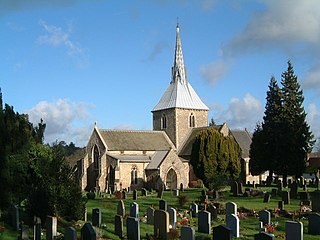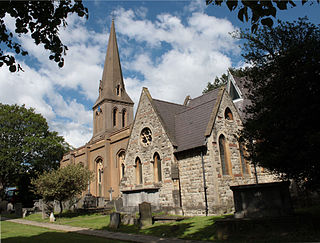
St Albans is a cathedral city in Hertfordshire, England and the main urban area in the City and District of St Albans. It lies east of Hemel Hempstead and west of Hatfield, about 20 miles (32 km) north-north-west of central London, 8 miles (13 km) south-west of Welwyn Garden City and 11 miles (18 km) south-south-east of Luton. St Albans was the first major town on the old Roman road of Watling Street for travellers heading north and it became the Roman city of Verulamium. It is within the London commuter belt and the Greater London Built-up Area. With a population of 82,146, it is the fourth-most-populous settlement in Hertfordshire.

The City and District of St Albans is a local authority district in Hertfordshire in the East of England region. The main urban settlements are St Albans and Harpenden. The council offices are in St Albans.

Harpenden is a town and civil parish in the City and District of St Albans in the county of Hertfordshire, England. The population of the built-up area was 30,240 in the 2011 census, whilst the population of the civil parish was 29,448. Harpenden is a commuter town, with a direct rail connection through Central London and property prices well over triple the national average.

Wheathampstead is a village and civil parish in Hertfordshire, England, north of St Albans. The population of the ward at the 2001 census was 6,058. Included within the parish is the small hamlet of Amwell.

The Diocese of St Albans forms part of the Province of Canterbury in England and is part of the wider Church of England, in turn part of the worldwide Anglican Communion.

St Albans is a constituency represented in the House of Commons of the UK Parliament since 2019 by Daisy Cooper, a Liberal Democrat.

Hitchin and Harpenden is a constituency represented in the House of Commons of the UK Parliament since 2017 by Bim Afolami, a Conservative.

Nomansland Common is an area of common land in Hertfordshire, England to the south of Harpenden and the south-west of Wheathampstead

St Stephen's Church is a Church of England parish church in St Albans, Hertfordshire, England. It is located to the south of the town centre, at the top of St Stephen's Hill. It is a Grade II* listed building.

St Peter's Church is a Church of England parish church. It is located in St Albans, England, at the northern end of the town centre.

St Helen's Church is the oldest church in Wheathampstead, Hertfordshire, England, although the date of its origins is unknown. The wooden Anglo-Saxon structure pre-dated the Norman conquest of England, but no records survive which establish the date upon which it was founded. It is a Grade I listed building.

The Church of St Nicholas in Norton in Hertfordshire is the parish church for what was originally the village of Norton but which today has become a suburb of Letchworth Garden City. The present building dates from about 1109 to 1119, with additions in the 15th century including the tower. Before the Reformation it was a stopping point on the pilgrim route to the Abbey of St Albans and the shrine there.

St Edmund's Church is the Roman Catholic parish church of Godalming, a town in the English county of Surrey. It was built in 1906 to the design of Frederick Walters and is a Grade II listed building. The church stands on a "dramatic hillside site" on the corner of Croft Road just off Flambard Way close to the centre of the town.

St Mary with St Alban is the Church of England parish church of Teddington in the London Borough of Richmond upon Thames. It comprises the church of St Mary and the former church of St Alban nearby. The vicar is the Reverend Joe Moffatt.

St Leonard's Church is a Church of England parish church in the London Borough of Lambeth. It is a Grade II listed building and occupies a prominent position on the west side of Streatham High Road, at its junction with Tooting Bec Gardens and Mitcham Lane.

St Mary the Virgin is the parish church of Monken Hadley. It is located in the Diocese of London.

St Mark's Church, Barnet Vale is the Church of England parish church for Barnet Vale. It is located in the Diocese of St Albans. It is a Grade II listed building.

The Church of St Mary and St Thomas is one of two Anglican churches in Knebworth, Hertfordshire, England. The church dates from the twelfth century and is a grade I listed building.

The Church of St Mary the Virgin is the Church of England parish church of Letchworth in Hertfordshire. A church appears to have been on the site since before the Norman Conquest. The current church was built in the late 12th century and is Grade II listed. It comes under the Diocese of St Albans. The original dedication of the church is unknown; it was rededicated to St Mary during the First World War.

St Lawrence Church is an eighteenth-century, neoclassical church in Ayot St Lawrence, Hertfordshire, England. It is also known as New St Lawrence Church to distinguish it from the ruined Old St Lawrence Church.





















